What is Initial Consonant Deletion?
Initial consonant deletion is the phonological process when a child consistently leaves off consonants from the beginning of words. For example, “stick” becomes “ick” and “tree” becomes “ee”. While young children often leave consonants off of the ends of words, it is not common for children to delete beginning consonants. For this reason, initial consonant deletion is considered an atypical speech error. Children with this type of speech error would benefit greatly from being evaluated by a speech-language pathologist.
Consonant Deletion Age of Elimination
Initial consonant deletion is considered a phonological disorder. This means that the child has developed a rule in his/her head for how sounds will be used. For this particular phonological disorder, that rule is that all consonants at the beginning of words will be deleted. Keep in mind that the child is not doing this on purpose. That is just his brain’s way of making words easier for him to say. Another type of consonant deletion is final consonant deletion. In this process, children omit the final consonants off of words.
Phonological processes are a normal part of speech development for young children and so we expect to see many of these until a child grows out of them. When should consonant deletion disappear? Well, we expect children to use final consonant deletion up until three years of age. At that point, it tends to resolve on its own. If a child doesn’t stop using final consonant deletion by that time, we may want to start therapy.
When does initial consonant deletion disappear?
This one is more complicated. Deleting initial consonants is not a common phonological process that most children use. So there isn’t a specific age that we consider it “typical” to use. For that reason, when we see this type of consonant deletion at any age, we want to go ahead and get that child evaluated for speech therapy. The presence of this type of speech error could indicate a problem with the child’s phonological system that may require therapy to overcome.
Initial Consonant Deletion Speech Therapy Activities:
The goal of therapy for initial consonant deletion is for the child to start producing those consonants at the beginning of words. Here’s the step-by-step process (with activities!) for treating this condition:
1. Auditory Discrimination
The first step is to help the child hear the difference between words that should have a beginning consonant and words that should not. Find minimal pairs of words that are exactly the same except that one has an initial consonant and one does not. Examples would be “up” and “cup” or “off” and “cough”. You can use my word list below or make up your own. Free Printable Worksheets are Available in our Material Library
Initial Consonant Deletion Minimal Pairs
up/cup
up/pup
at/cat
at/mat
at/bat
at/sat
at/rat
at/fat
at/hat
out/spout
out/shout
in/pin
in/tin
in/fin
in/grin
in/shin
in/thin
in/spin
over/clover
on/lawn
itch/witch
ask/mask
egg/leg
egg/beg
end/send
end/bend
el (L)/shell
el (L)/bell
ill/Bill
off/cough
awesome/possum
under/thunder
ouch/couch
all/tall
arm/farm
art/cart
ear/tear
ear/fear
eat/seat
eat/sheet
eel/seal
ice/rice
ice/nice
oat/coat
Get Pictures of Those Words: You will need to show the child pictures of those words. You can find pictures using Google Image Search, take your own pictures, or draw pictures. Or, purchase our initial consonant deletion no-prep therapy kit that has them all done for you!
Tell the child what each word is called (“this is cup, this is up”) and then ask the child to point to one of the words. See if the child can hear the difference between the two words. You may need to play games to get the child to do this. Here’s a video with a fun game called “hide the penny” that works great for this!
2. Single Words
Once the child can point to the correct picture about 80% of the time, you’re ready to have the child say those words. Show the child a minimal pair of two words again. Help the child say each word, one with a beginning consonant and one without. If the child is struggling to say the beginning consonant, have him say the consonant by itself first, then say the whole thing. You may have to allow the child to pause between the beginning sound and the word for now, then gradually work on eliminating the pause.
3. Phrases and Sentences
Now it’s time to help the child start using beginning consonants in short phrases and eventually sentences. Start by having the child say a repeating phrase like “my ____” or “no _____”. Cycle through the words he or she has already practiced in the previous step. Once the child is successful with that, you can start increasing the phrase length up through simple sentences.
4. Conversational Speech
Once the child is able to say the sound in sentences, you’ll want to work on the sound in conversation. For more information on practicing sounds in conversation, check out my post on increasing self-awareness and carry-over: Click Here to Learn About Teaching Sounds in Conversation
Initial Consonant Deletion Resources:
Check out our additional resources on treating initial consonant deletion:
Free Therapy Materials for Treating Phonology:
Check out the freebies that we have inside our Free Therapy Material Library!
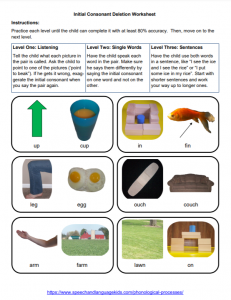
Initial Consonant Deletion Worksheet
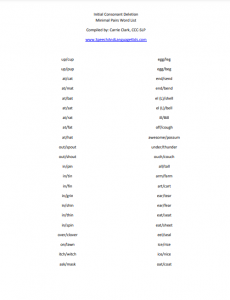
Initial Consonant Deletion Minimal Pairs Word List
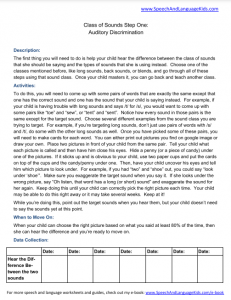
Guide to Teaching a Sound Class (Phonological Approach)
Listen to the Podcast Version Here:

About the Author: Carrie Clark, MA CCC-SLP
Hi, I’m Carrie! I’m a speech-language pathologist from Columbia, Missouri, USA. I’ve worked with children and teenagers of all ages in schools, preschools, and even my own private practice. I love digging through the research on speech and language topics and breaking it down into step-by-step plans for my followers.
Fun Fact: I ran my own private practice for several years. I rented an office out of the back of my childhood pediatrician’s office and only accepted cash pay patients. We had enough of a need in my area that I didn’t need to bill insurance. I closed the practice when my online business was taking off enough that I needed to dedicate my time to it full time. I referred all of my patients/clients to a friend of mine who was opening her practice. I have since worked for her practice when I wanted to get back into direct client contact for a bit.
Connect with Me:
Podcast: Play in new window | Download | Embed
Subscribe: Apple Podcasts | RSS

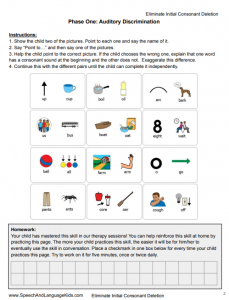
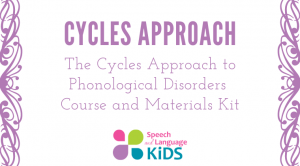





I have a student who has struggled with many initial consonant deletions and slow but steady gains have been made. Currently, this student can produce /v/ and /z/ in the initial position of words but not the voiceless cognates /f/ and /s/. To compensate she will sometimes segment the word , for example, /s/ /op/ for “soap”. In other words she can’t blend the initial voiceless consonant with the vowel that follows. Any suggestions
I just had another reader ask me about that on another post, must be a common problem! Here are my thoughts:
I can’t tell you specifically what to do with that child since I don’t know her but I can tell you some of the things I’ve tried when I’ve had a child who was stuck on a sound or having trouble putting the sound together without gaps:
1. Try giving that sound a break and working on a different sound for a bit and coming back to it
3. Go back to the syllable level and practice saying the sound just with one vowel in a non-sense syllable, like “fuh, foh, foo”
Hope that helps! Good luck!
This is so helpful! My daughter is 27 months and is a little slower to learn lots of words, and definitely has this ICD issue. Have you seen this exercise work for children this young who still don’t have a ton of words in their vocabulary?
This can definitely be harder to work on with younger children but is worth a try! This is the first type of exercise that a speech-language therapist will try with a child to fix ICD and if it doesn’t work, we have a ton of other tricks in our bags that we can try. I just can’t include them all here because they depend a lot on what the child is struggling with. The best advice I can give you is to seek a speech-language therapist in your area who can help you with this in person!
We’ve been struggling with initial consonant deletion. My son is 27 months, and has been very apt to contract colds/have fluid on his ears. I’m personally worried about ICD, but our doctor (whom I love and trust) says he’s young enough that this isn’t concerning, and still typical. He wouldn’t refer us for an evaluation. Do you agree with his evaluation, or should I push forward and seek another opinion?
Initial consonant deletion is considered an atypical phonological process. It is not one that we see present in children with normal phonological development. I can’t tell you what’s best for your child since I haven’t worked with him, but atypical phonological processes, such as initial consonant deletion, are generally a red flag that would at least warrant an evaluation. Speech-language pathologists do not need a referral to see children (unless insurance requires one). I hope that helps. I’m not strictly allowed to give medical advice over the internet so general information like this is the best I can do.
Hello. I am a speech pathologist working with a severely hypernadal 4 year old who also eliminated initial consonants, p f t , all voiceless. Trying many programs including kaufman but little success. He SN produce these sounds in medial And final positions. It’s stumping me!! Any ideas?
This is my general advice for initial consonant deletion. We’re able to help troubleshoot more problems in the paid membership, but without knowing more about the case, I can’t offer much else on here. You’re welcome to check out our group though:
https://www.speechandlanguagekids.com/become-a-member/
My daughter will be 2 in about a month and she does this with all her words. She has about 100 words ( most only I understand) and only pronounces the beginning if it starts with a vowel. Is it time for an eval or will she pick it up on her own?
Initial consonant deletion is not an error that we typically see in children so it is almost always worth getting it looked at by a speech-language pathologist!
My son is 17 months and it is obvious that he is struggling with initial consonant deletion. I can’t get him to make an initial consonant sound for the life of me. Even exaggerating the sound, he will still say the word without it. Any ideas for someone so young? I want to start intervening as early as possible, but I’m sure the exercises you detailed are too much for his age. I’m so anxious about this affecting his speech long term, as well as his reading and literacy skills in the future. I feel like if I don’t get this fixed quickly, I’m setting him up for failure. We have contacted a SLP but have not heard back yet.
My 4 yr old son was diagnosed as nonverbal autistic he has some clear understandable words others he leaves the first letter off ex we is eee and you is ewe. Also he like to use d ex bus is duh he leaves off the ending on some green is gree and someti.es when you ask him to say what your saying he sort of mimics the sound of it in his own way it’s very similar in sound but not actual words. BUT most of the time he just makes his own noises and sounds. He’s very high functioning understands well the only true autistic behaviors that are noticeable is speech and lack of eye contact.
Hi Carrie, thank you for addressing this! My son (26 months) is exhibiting signs of ICD and has been in speech therapy since 18 months for speech delay (he has had chronic ear infections and also got tubes around this time). Now that he is talking a lot and speech delay is no longer a concern, we are keeping him in therapy at the recommendation of his therapist because of his “atypical articulation”/signs of ICD. I have a couple of questions about ICD:
-are you aware of how common ICD is in the U.S.? I understand it is not considered normal speech development but how likely is it that my kid actually has this disorder? My therapist said they can’t diagnose until he is older.
-is this a disorder than can be overcome with speech therapy, or is it very difficult to correct? In other words, will my son always have trouble with this if he truly has ICD?
-Do children with ICD leave off ALL initial consonants or only some? The reason I ask is my son does articulate the initial consonant of some words but frequently doesn’t articulate the initial consonant of bilabial sounds. He especially has trouble with “p’s” but is starting to do a lot better with “m” and “b”. He has no problem articulating an initial “c” and some other non-bilabial sounds.
-Finally since he has been born he has been learning two languages (Spanish and English). Do you think this could have anything to do with why he is struggling with certain consonant sounds? The therapists we are working with do not have much, if any, experience with bilingual children so I’m trying to learn if this second language could have any impact on his speech struggles.
Thanks for any additional information you can provide!
Two out of three of my children do this. It is quite uncommon but a speech therapist once told me that there might be a genetic component to it. It is interesting since I also had the same exact speech issue as a child. My middle son began speech therapy when he was 2 because he wasn’t speaking at all and is still in speech therapy at age 7 due to this initial consonant deletion. Slow and steady gains! He is nearly completely intelligible as long as he slows his rate of speech. My three-year-old is now showing the same speech pattern so I plan to have him evaluated very soon for speech services as well. Thanks for the tips on working on this at home. That will be useful until we can be seen by a provider.
What other problems are common with ICD?
I see these posts are older. My son is 3 years 4months. My son never really had alot of words when he turned 2 we started sooner start the evaluation qualified him for speech. He slowly gained a few 10 words . At this point 2.5 yrs old her knew all his letter and numbers by 3 he could say numbers up to 50. We noticed him saying letter bc it was along with the song ABC’s. At this point I was able to tell the speech therapist that all his letters like e t p c d sound alike. He doesnt communicate in sentences but we will say eat daddy very clear he used to say mama as a baby but stopped . Now he says ommy. He never addresses me or asks for me by name. I started asking his questions like what is your name what is his name he will say daddy or his brother jo jo is “o”o” … so we did another evaluation at 3yrs 3 months and they mention expressive language needs work, also he needs help with initial letters in words. I havent got a break down of any of what anything means. I’m not sure what to ask but I also have been in childcare for years so I’ve always read to him talked and done alot of intervention methods. I’m just not sure what this all.means. what
Hello! Thank you so much for reaching out. Unfortunately, we get a ton of questions every day about how to solve specific speech/language problems. Since we have such a small staff, we aren’t able to answer every question that comes through on the website, social media, or via email. If you are a parent, we suggest you reach out to a local speech-language pathologist who can work with your child directly and answer your question.
If you are another speech-language professional, we have created a membership where we pay a full staff to answer questions like this on a regular basis. We would be more than happy to answer your question inside the membership program. We’re able to answer more questions in here because we have a full library of questions that we’ve already answered so our staff can either link you to the answer if it exists, or write you a custom response if needed. We’d love to see you inside the membership!
Click Here to Become a Member: https://www.slpsolution.com/pediatric-signup/.
my daughter turns 3 in a week. She initially could pronounce /s/, /p/ and /f/ words properly like snake, play and butterfly. 2 months after she started playgroup class, these sounds disappeared ( nake, lay and butterly). The thing is , she would say the sound but not pronounce it in the word ( /s/ as in nake) and when you say it for her to repeat, she repeats with the omitted initial sounds. My worry is that she could pronounce these words before. Any suggestions?
Hi, Austen-
Hello! Thank you so much for reaching out. Unfortunately, we get a ton of questions every day about how to solve specific speech/language problems. Since we have such a small staff, we aren’t able to answer every question that comes through on the website, social media, or via email. If you are a parent, we suggest you reach out to a local speech-language pathologist who can work with your child directly and answer your question.
If you are another speech-language professional, we have created a membership where we pay a full staff to answer questions like this on a regular basis. We would be more than happy to answer your question inside the membership program. We’re able to answer more questions in here because we have a full library of questions that we’ve already answered so our staff can either link you to the answer if it exists, or write you a custom response if needed. We’d love to see you inside the membership!
Click Here to Become a Member: https://www.slpsolution.com/pediatric-signup/
Suggest few exercises for kids who have shown signs of stuttering while producing S,I,K,L and H letter in initial speech?
Hi, Madiha-Here is a link to some resources on Carrie’s site for stuttering: https://www.speechandlanguagekids.com/?s=stuttering. Please let us know if you need anything else.
At what age is this a concern? My 14 month old daughter uses the /k/ sound in a really emphasized way to label things with that final consonant, such as cook, book, milk, duck, truck, shark, etc. sometimes they sound slightly different and I know what she’s saying based on that or context and she has several other words/signs/sounds/approximations so I know she’s not just using that sound randomly. Is this cause for concern at this time?
Hello, Kahla!
Thank you so much for reaching out. Unfortunately, we get a ton of questions every day about how to solve specific speech/language problems. Since we have such a small staff, we aren’t able to answer every question that comes through on the website, social media, or via email. If you are a parent, we suggest you reach out to a local speech-language pathologist who can work with your child directly and answer your question.
If you are another speech-language professional, we have created a membership where we pay a full staff to answer questions like this on a regular basis. We would be more than happy to answer your question inside the membership program. We’re able to answer more questions in here because we have a full library of questions that we’ve already answered so our staff can either link you to the answer if it exists, or write you a custom response if needed. We’d love to see you inside the membership!
Click Here to Become a Member: https://www.slpsolution.com/pediatric-signup/
Hi, I have a child who deletes the initial consonant and replaces it with “H” sound.
Hat for cat, hog for dog, hood for good, hum for mum, haay house for play house.
Hello, Nancy!
Thank you so much for reaching out. Unfortunately, we get a ton of questions every day about how to solve specific speech/language problems. Since we have such a small staff, we aren’t able to answer every question that comes through on the website, social media, or via email. If you are a parent, we suggest you reach out to a local speech-language pathologist who can work with your child directly and answer your question.
If you are another speech-language professional, we have created a membership where we pay a full staff to answer questions like this on a regular basis. We would be more than happy to answer your question inside the membership program. We’re able to answer more questions in here because we have a full library of questions that we’ve already answered so our staff can either link you to the answer if it exists, or write you a custom response if needed. We’d love to see you inside the membership!
Click Here to Become a Member: https://www.slpsolution.com/pediatric-signup/
Thank you so much for this!! I’m a new SLPA and have been having a difficult time with a kiddo who’s been working specifically on initial /h/. He can say it in isolation but then separates it from the rest of the word when attempting at the word level. Can’t wait to try the penny game!
You are more thank welcome, Kylie! Please let us know if you have any questions.